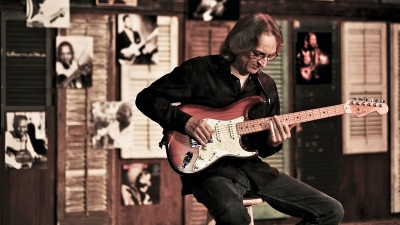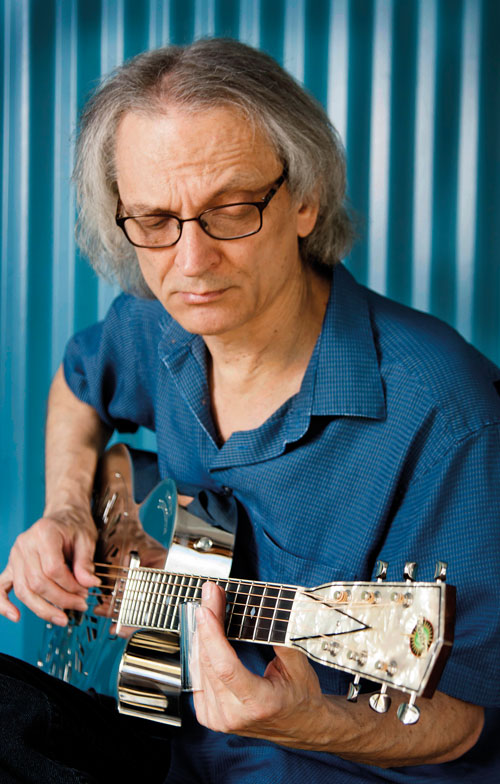Sonny Landreth's 11 tips for guitarists
Wisdom from Lafayette's slide guitar legend

A new double live-album sees the slide maestro playing both electric and acoustic guitars in a set from his hometown of Lafayette, Louisiana…
When we mention to Sonny that it’s nice to hear him playing acoustic on his new album, he says: “A lot of people don’t know there was a two-year period in my career when I didn’t even pick up an electric guitar. I bought a Martin D-28 from a friend of mine and I had a metalbodied Dobro - and that’s all I played.”
So, in a way, Recorded Live In Lafayette is a return to his roots and a splendid opportunity to hear an often-overlooked side of an artist whose slide style is a wonder to behold. Recorded over three nights in an intimate club, the album revisits material from across the span of Sonny’s career, with an eclectic set of instruments, including a resonator guitar built around a ’56 Oldsmobile hubcap!
1. There’s no place like home
“I’d been thinking about doing an all-acoustic album - I haven’t done that since 1973 and it had been a long time since we’d done a live album. To be honest, I struggled with what to do and how to do it.
“We’d played a show in the theatre where we did the recording in my hometown, Lafayette, Louisiana. It’s a beautiful room. It just made sense: all our resources are here in terms of my engineer, who lives down the street with all his equipment, and I’ve got all my gear here and the whole band and everything. So we really just kinda went for all of it.”
2. Choose your material well
I thought Blues Attack was a no-brainer because the original version in 1981 wasn’t on acoustic and we’d never done it like that
“Many of these songs were written in different ways. Sitting down with an electric guitar that isn’t plugged in, you just get an idea and then you go plug it in - or you have an acoustic guitar and vice versa.
“For me, I thought which songs would be the most interesting in terms of perhaps they’d been more of a production piece in the studio, had been done electric before, and which ones would translate. So I just kinda took it from there. I thought Blues Attack was a no-brainer because the original version in 1981 wasn’t on acoustic and we’d never done it like that with accordion.”
Want all the hottest music and gear news, reviews, deals, features and more, direct to your inbox? Sign up here.
3. Instrumentation is an important element

“Another factor is what instruments do you use to make these songs speak? So I stuck with a resonator approach and my old friend Sam Broussard - he and I grew up learning how to play guitar together, he’s a fantastic guitarist and singer-songwriter - he had his vintage Martin parlour guitar and Dave [Ranson], our bass player, brought a ukulele bass to the studio on the last album, Bound By The Blues, and I looked at it and said, ‘What are we going to do with that little thing?’ It looked really cool, you know, and we plugged it in and I couldn’t believe the sound. It was amazing - and that probably inspired me to think in terms of this album.”
4. Use textures that suit the material
“Brian Brignac, our drummer, played the cajón, so I thought that was a great foundation with Steve Conn on accordion - who is probably the greatest [accordion player] in the world. He’s an old friend and he’s worked on all my albums. It was good to have that connection and for them to bring their talents to it.
“I just took that and I thought, with a song like A World Away, it’s really different for that - and another song we hadn’t done in years was Creole Angel. I always thought that was one we could get back to and do something different with - I don’t know why, I just did. So that’s kinda how that came about.”
5. Inspiration can be hanging on a shop wall
“I got my first metal-bodied Dobro when Ed Dopyera started making those again in the early 1970s. I bought it off the wall in a music store in Houston, Texas. I was in town there with a big horn band, and we had a two-week gig at a local club. I remember going to the band leader and he gave me an advance for the two weeks, and I went and bought the Dobro. I hadn’t been there two days yet and I’d spent all my money!
“It was $300 and I was so inspired by that - it meant that, finally, I could get something like that sound I’d been hearing on those old albums.”
6. You have to ride with the changes
“There’s a very special thing that happens acoustically - and it’s true with all acoustic guitars. It changes the sound so much to put a pickup on it, but I think more so with the biscuit version [resonators], because that pressure with the strings directly onto the cone has a thing that happens with compression.
“It affects it so much with the dynamics and the harmonics - I can’t find a great way to translate that just yet, but I’m working on it. Larry Fishman is a really good friend of mine, so we’re in the process of tackling it. My approach is so different to a lot of other people and that’s probably more of the problem than anything else.”
7. Put a cap on it
Larry Pogreba would take these old hubcaps from vintage cars, cut them and use that for the cover. Mine's a '56 Oldsmobile
“My main [guitar] is the hubcap resonator guitar that Larry Pogreba made. I was in Colorado and he came up on the bus and somebody said, ‘There’s a guy here who says he has a guitar that you want to see.’ He’s a real eccentric luthier and a really creative guy. He’d take these old hubcaps from vintage cars, cut them and use that for the cover.
“What’s amazing is that round the piece in the centre - mine’s a ’56 Oldsmobile - is real comfortable for the palm. It doesn’t sound like my vintage Nationals or my Dobro; it doesn’t have that midrange punch. It’s brighter and has more ‘air’ at the top end, which is really nice for harmonics.”
8. Old tech can have its own rewards
“There is an old Teisco pickup on the neck [of the hubcap reso] and that thing’s so microphonic that it picks up a lot of the vibe of the guitar. We layered the sound more by taking a split off of that pickup - one to feed to my pedalboard, the other went DI to out front - then we put an open mic on it, so whatever I did with my amp on stage made somewhat of a composite sound with the DI and the microphone. You can get some really interesting textures. I’d like to experiment with that more in the future.”
9. Learn to tame the beast

“What I found was really great for that Teisco pickup was the Elevator by Radial Engineering. I’d heard a lot of players liked those and I thought, ‘Well, let me try it out.’ It’s really compatible with both the magnetic pickup or with a piezo. You can also select a little mid-boost; it’s got two different frequency points that boost the mids just a little, and it worked great with that Teisco pickup. From there I ran into Mike Fuller’s [Fulltone] Plimsoul pedal - every now and then I just kick that on, for a funky, back-porch Delta vibe.”
10. We all like surprises…
“The other guitar I played in our acoustic set recording was a Steve Evans Beltona Electro-Resonator steel-bodied guitar that Mark Knopfler asked Steve to build for me as a gift. I was in Nashville in the mid-90s when it showed up - a total surprise!
“It has a smaller body with a cutaway design that is easy to play and sounds great with a punchy midrange akin to the vintage Nationals. The P-90-style pickup in the neck position was, I believe, made by Steve. Also, Mark had him engrave my name in a circular form on the upper left shoulder and it is, in fact, on the cover of my new album…”
11. Never deny the power of a good song
“If you have a good song, I’ve always felt it can be interpreted in any way. That’s what’s cool about going back to an acoustic version: there’s an element of percussion that’s much more important. So melodically and harmonically, you find different ways to interpret that - variations on themes and finding new ways to say something. It has to be musical and have something to say.”

